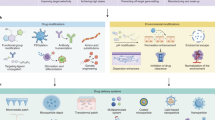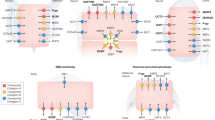Abstract
The drug–target residence time model was first introduced in 2006 and has been broadly adopted across the chemical biology, biotechnology and pharmaceutical communities. While traditional in vitro methods view drug–target interactions exclusively in terms of equilibrium affinity, the residence time model takes into account the conformational dynamics of target macromolecules that affect drug binding and dissociation. The key tenet of this model is that the lifetime (or residence time) of the binary drug–target complex, and not the binding affinity per se, dictates much of the in vivo pharmacological activity. Here, this model is revisited and key applications of it over the past 10 years are highlighted.
This is a preview of subscription content, access via your institution
Access options
Subscribe to this journal
Receive 12 print issues and online access
$209.00 per year
only $17.42 per issue
Buy this article
- Purchase on Springer Link
- Instant access to full article PDF
Prices may be subject to local taxes which are calculated during checkout




Similar content being viewed by others
References
Copeland, R. A., Pompliano, D. L. & Meek, T. D. Drug–target residence time and its implications for lead optimization. Nat. Rev. Drug Discov. 5, 730–739 (2006).
Tummino, P. J. & Copeland, R. A. Residence time of receptor–ligand complexes and its effect on biological function. Biochemistry 47, 5481–5492 (2008).
Copeland, R. A. The dynamics of drug–target interactions: drug–target residence time and its impact on efficacy and safety. Expert Opin. Drug Discov. 5, 305–310 (2010).
Copeland, R. A. Conformational adaptation in drug–target interactions and residence time. Future Med. Chem. 3, 1491–1501 (2011).
Copeland, R. A. Evaluation of Enzyme Inhibitors in Drug Discovery: A Guide for Medicinal Chemists and Pharmacologists (Wiley, 2013).
Schiele, F., Ayaz, P. & Fernandez-Montalvan, A. A universal homogeneous assay for high-throughput determination of binding kinetics. Anal. Biochem. 468, 42–49 (2014).
Zhang, R. & Windsor, W. T. in Antiviral Methods and Protocols, Methods in Molecular Biology (ed. Gong, E. Y.) 59–79 (2013).
Copeland, R. A. et al. Mechanism of selective inhibition of the inducible isoform of prostaglandin G/H synthase. Proc. Natl Acad. Sci. USA 91, 11202–11206 (1994).
Bull, H. G. et al. Mechanism-based inhibition of human steroid 5α-reductase by finasteride: enzyme catalyzed formation of NADP-dihydrofinasteride, a potent bisubstrate analog inhibitor. J. Am. Chem. Soc. USA 118, 2359–2365 (1996).
Gooljarsingh, L. T. et al. A biochemical rationale for the anticancer effects of HSP90 inhibitors: slow, tight binding inhibition by geldanamycin and its analogues. Proc. Natl Acad. Sci. USA 103, 7625–7630 (2006).
Morrison, J. F. & Walsh, C. T. The behavior and significance of slow-binding enzyme inhibitors. Adv. Enzymol. Relat. Areas Mol. Biol. 61, 201–299 (1988).
Danielson, U. H. Integrating surface plasmon resonance biosensor-based interaction kinetic analyses into the lead discovery and optimization process. Future Med. Chem. 1, 1399–1414 (2009).
Dahl, G. & Akerud, T. Pharmacokinetics and the drug–target residence time concept. Drug Discov. Today 18, 697–707 (2013).
Zhang, R. & Monsma, F. The importance of drug–target residence time. Curr. Opin. Drug Discov. 12, 488–496 (2009).
Lu, H. & Tonge, P. J. Drug–target residence time: critical information for lead optimization. Curr. Opin. Chem. Biol. 14, 467–474 (2010).
Hyre, D. E. et al. Cooperative hydrogen bond interactions in the streptavidin–biotin system. Protein Sci. 15, 459–467 (2006).
Maschera, B. et al. Human immunodeficiency virus: mutations in the viral protease that confer resistance to saquinavir increase the dissociation rate constant of the protease–saquinavir complex. J. Biol. Chem. 271, 33231–33235 (1996).
Basavapathruni, A. et al. Conformational adaption drives potent, selective and durable inhibition of the human protein methyltransferase DOT1L. Chem. Biol. Drug Des. 80, 971–980 (2012).
Schneider, E. V., Bottcher, J., Huber, R., Maskos, K. & Neumann, L. Structure–kinetic relationship study of CDK8/CycC specific compounds. Proc. Natl Acad. Sci. USA 110, 8081–8086 (2013).
Zhang, R. Which trails are your drugs taking? Nat. Chem. Biol. 11, 382–383 (2015).
Markgren, P.-O. et al. Relationships between structure and interaction kinetics for HIV-protease inhibitors. J. Med. Chem. 45, 5430–5439 (2002).
Vauquelin, G. Rebinding: or why drugs may act longer in vivo than expected from their in vitro target residence time. Expert Opin. Drug Discov. 5, 927–941 (2010).
Vauquelin, G. & Charlton, S. J. Long-lasting target binding and rebinding as mechanisms to prolong in vivo drug action. Br. J. Pharmacol. 161, 488–508 (2010).
Li, H.-J. et al. A structural and energetic model for the slow-onset inhibition of the Mycobacterium tuberculosis enoyl-ACP reductase InhA. ACS Chem. Biol. 9, 986–993 (2014).
Lai, C.-T. et al. Rational modulation of the induced-fit conformational change for slow-onset inhibition of Mycobacterium tuberculosis InhA. Biochemistry 54, 4683–4691 (2015).
Tiwary, P., Limongelli, V., Salvalaglio, M. & Parrinello, M. Kinetics of protein–ligand unbinding: predicting pathways, rates and rate-limiting steps. Proc. Natl Acad. Sci. USA 112, E386–E391 (2009).
Cusack, K. P. et al. Design strategies to address kinetics of drug binding and residence time. Bioorg. Med. Chem. Lett. 25, 2019–2027 (2015).
Van Aller, G. et al. Long residence time inhibition of EZH2 in activated polycomb repressive complex 2. ACS Chem. Biol. 9, 622–629 (2014).
Chan-Penebre, E. et al. A selective inhibitor of PRMT5 with in vivo and in vitro potency in MCL models. Nat. Chem. Biol. 11, 432–437 (2015).
Lu, H. et al. Slow-onset inhibition of the FabI enoyl reductase from Francisella tularensis: residence time and in vivo activity. ACS Chem. Biol. 4, 221–231 (2009).
Guo, D., Mulder-Krieger, T., Ijzerman, A. P. & Heitman, L. H. Functional efficacy of adenosine A2A receptor agonists is positively correlated to their receptor residence time. Br. J. Pharmacol. 166, 1846–1859 (2012).
Sullivan, S. M. & Holyoak, T. Enzymes with lid-gated active sites must operate by an induced fit mechanism instead of conformational selection. Proc. Natl Acad. Sci. USA 105, 13829–13834 (2008).
Garvey, E. P. et al. Potent inhibitors of HIV-1 integrase display a two-step, slow-binding inhibition mechanism which is absent in a drug-resistant T661/M1541 mutant. Biochemistry 48, 1644–1653 (2009).
González, B. et al. The crystal structure of tetrameric methionine adenosyltransferase from rat liver reveals the methionine-binding site. J. Mol. Biol. 300, 363–375 (2000).
Pearce, F. G. & Andrews, T. J. The relationship between side reactions and slow inhibition of ribulose-bisphosphate carboxylase revealed by a loop 6 mutant of the tobacco enzyme. J. Biol. Chem. 278, 32526–32536 (2003).
Liu, Y. et al. Hepatitis C NS3 protease inhibition by peptidyl-α-ketoamide inhibitors: kinetic mechanism and structure. Arch. Biochem. Biophys. 421, 207–216 (2004).
Kapoor, M. et al. Kinetic and structural analysis of the increased affinity of enoyl-ACP (acyl-carrier protein) reductase for triclosan in the presence of NAD. Biochem. J. 381, 725–733 (2004).
Carroll, M. J. et al. Evidence for dynamics in proteins as a mechanism for ligand dissociation. Nat. Chem. Biol. 8, 246–252 (2012).
Luckner, S. R. et al. A slow, tight binding inhibitor of InhA, the enoyl-acyl carrier protein reductase from Mycobacterium tuberculosis. J. Biol. Chem. 285, 14330–14337 (2010).
Cowan-Jacob, S. W., Mobitz, H. & Fabbro, D. Structural biology contributions to tyrosine kinase drug discovery. Curr. Opin. Cell Biol. 21, 280–287 (2009).
Luong, C. et al. Flexibility of the NSAID binding site in the structure of human cyclooxygenase-2. Nat. Struct. Biol. 3, 927–933 (1996).
Schmidtke, P., Luque, F. J., Murray, J. B. & Barril, X. Shielded hydrogen bonds as structural determinants of binding kinetics: application in drug design. J. Am. Chem. Soc. 133, 18903–18910 (2011).
Bradshaw, J. M. et al. Prolonged and tunable residence time using reversible covalent kinase inhibitors. Nat. Chem. Biol. 11, 525–531 (2015).
Walkup, G. K. et al. Translating slow-binding inhibition kinetics into cellular and in vivo effects. Nat.Chem. Biol. 11, 416–423 (2015).
Billheimer, J. T. et al. Evidence that thrombocytopenia observed in humans treated with orally bioavailable glycoprotein IIb/IIIa antagonists is immune mediated. Blood 99, 3540–3546 (2002).
Seiffert, D. et al. Prospective testing for drug-dependent antibodies reduces the incidence of thrombocytopenia observed with the small molecule glycoprotein IIb/IIIa antagonist roxifiban: implications for the etiology of thrombocytopenia. Blood 101, 58–63 (2003).
Norman, A. W., Mizwicki, M. T. & Norman, D. P. Steroid-hormone rapid actions, membrane receptors and a conformational ensemble model. Nat. Rev. Drug Discov. 3, 27–41 (2004).
Kapur, S. & Seeman, P. Antipsychotic agents differ in how fast they come off the dopamine D2 receptors. Implications for atypical antipsychotic action. J. Psychiatry Neurosci. 25, 161–166 (2000).
Vauquelin, G., Bostoen, S., Vanderheyden, P. & Seeman, P. Clozapine, atypical antipsychotics, and the benefits of fast-off D2 dopamine receptor antagonism. Naunyn Schmiedebergs Arch. Pharmacol. 385, 337–372 (2012).
Swinney, D. C. Biochemical mechanisms of drug action: what does it take for success? Nat. Rev. Drug Discov. 3, 801–808 (2004).
Swinney, D. C. Molecular mechanism of action (MMoA) in drug discovery. Annu. Reports Med. Chem. 46, 301–317 (2011).
Keseru, G. M. & Swinney, D. C. Thermodynamics and Kinetics of Drug Binding (Wiley-VCH, 2015).
Ploeger, B. A., van der Graaf, P. H. & Danhof, M. Incorporating receptor theory in mechanism-based pharmacokinetic-pharmacodynamic (PK-PD) modeling. Drug Metab. Pharmacokinet. 29, 84–93 (2009).
Tillotson, B. et al. Hsp90 (heat shock protein 90) inhibitor occupancy is a direct determinant of client protein degradation and tumor growth arrest in vivo. J. Biol. Chem. 285, 39835–39843 (2010).
Acknowledgements
The author thanks the many colleagues who have contributed to the development and application of the drug–target residence time model since its initial inception. In particular the author thanks the following scientists for their significant contributions to the development of the model: C. T. Walsh, D. Swinney, P. Tonge, P. Tummino, S. Fisher, G. Walkup, G. Vauquelin, H. Danielson, D. Pompliano and T. Meek.
Author information
Authors and Affiliations
Corresponding author
Ethics declarations
Competing interests
R.A.C. is an employee of and shareholder in Epizyme, Inc. (USA). The author also serves on the scientific advisory boards of Mersana Therapeutics (USA) and Raze Therapeutics (USA).
Rights and permissions
About this article
Cite this article
Copeland, R. The drug–target residence time model: a 10-year retrospective. Nat Rev Drug Discov 15, 87–95 (2016). https://doi.org/10.1038/nrd.2015.18
Published:
Issue Date:
DOI: https://doi.org/10.1038/nrd.2015.18
This article is cited by
-
Modelling ligand depletion for simultaneous affinity and binding site quantification on cells and tissue
Scientific Reports (2023)
-
Transferring chemical and energetic knowledge between molecular systems with machine learning
Communications Chemistry (2023)
-
Quorum sensing-based interactions among drugs, microbes, and diseases
Science China Life Sciences (2023)
-
An integrated modelling approach for targeted degradation: insights on optimization, data requirements and PKPD predictions from semi- or fully-mechanistic models and exact steady state solutions
Journal of Pharmacokinetics and Pharmacodynamics (2023)
-
Semi-quantitatively Predicting the Residence Time of Three Natural Products on Endothelin Receptor A by Peak Profiling Using the Receptor Functionalized Macroporous Silica Gel as Stationary Phase
Journal of Analysis and Testing (2023)



